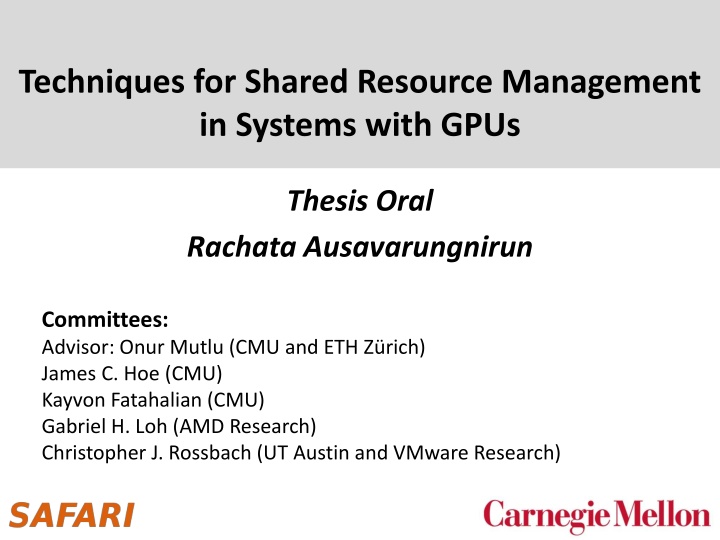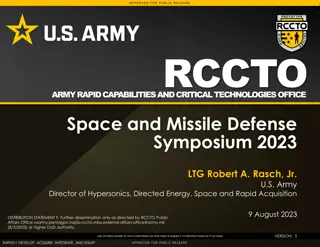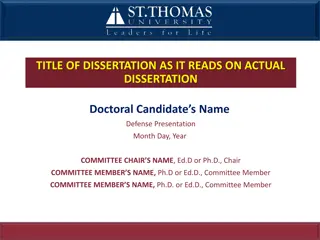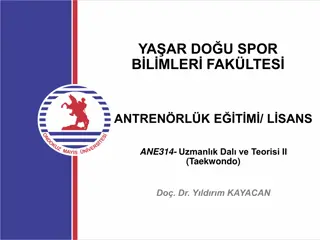
Techniques for Shared Resource Management in Systems with GPUs Thesis Oral
Explore the complexities of resource management in GPU systems through intra-application, inter-application, and inter-address-space memory interference. Learn about parallelism in GPUs and the impact of memory-intensive workloads on system performance.
Download Presentation

Please find below an Image/Link to download the presentation.
The content on the website is provided AS IS for your information and personal use only. It may not be sold, licensed, or shared on other websites without obtaining consent from the author. If you encounter any issues during the download, it is possible that the publisher has removed the file from their server.
You are allowed to download the files provided on this website for personal or commercial use, subject to the condition that they are used lawfully. All files are the property of their respective owners.
The content on the website is provided AS IS for your information and personal use only. It may not be sold, licensed, or shared on other websites without obtaining consent from the author.
E N D
Presentation Transcript
Techniques for Shared Resource Management in Systems with GPUs Thesis Oral Rachata Ausavarungnirun Committees: Advisor: Onur Mutlu (CMU and ETH Z rich) James C. Hoe (CMU) Kayvon Fatahalian (CMU) Gabriel H. Loh (AMD Research) Christopher J. Rossbach (UT Austin and VMware Research)
Parallelism in GPU GPU Core Status Time 8 Loads Warp A Warp B 32 Loads Active Warp C Warp D Lockstep Execution Thread Stall than memory-intensive CPU applications GPU is much more (4x-20x) memory-intensive Active GPU Core 2
Three Types of Memory Interference Intra-application Interference 3
Intra-application Interference GPU Core 32 Loads GPU Core GPU Core 32 Loads GPU Core GPU Core GPU Core Requests from GPU cores interfere at the cache and main memory Last Level Cache Last Level Cache Memory Controller Memory Controller Main Memory Main Memory 4
Three Types of Memory Interference Intra-application Interference Inter-application Interference 5
Inter-application Interference GPU Core GPU Core GPU Core CPU Core Core CPU CPU Core Core CPU CPU Core Core CPU CPU Core Core CPU GPU Core GPU Core GPU Core Load 100s Loads Last Level Cache Last Level Cache Memory Controller Memory Controller Requests from CPU and GPU contend and interfere at the main memory Main Memory Main Memory 6
Three Types of Memory Interference Intra-application Interference Inter-application Interference Inter-address-space Interference 7
Inter-address-space Interference GPU Core Core Core GPU GPU GPU Core Core Load GPU Core GPU GPU Core GPU Core Core Load Core GPU GPU CPU Core CPU Core CPU Core CPU Core GPU Core Core Core GPU GPU GPU Core Core GPU GPU Core Core Core GPU GPU Load Address translation is required to enforce memory protection Address Translation & TLB Address Translation & TLB Last Level Cache Last Level Cache Memory Controller Requests from multiple GPU applications interfere at the shared TLB Main Memory 8
Previous Works Cache management schemes Li et al. (HPCA 15), Li et al. (ICS 15), Jia et al. (HPCA 14), Chen et al. (MICRO 14, MES 14), Rogers et al. (MICRO 12), Seshadri et al. (PACT 12), Jaleel et al. (PACT 08), Jaleel et al. (ISCA 10) Does not take GPU s memory divergence into account Memory Scheduling Rixner et al. (ISCA 00), Yuan et al. (MICRO 09), Kim et al. (HPCA 10), Kim et al. (MICRO 10), Mutlu et al. (MICRO 07), Kim et al. (MICRO 10) Does not take GPU s traffic into account TLB designs Power et al. (HPCA 14), Cong et al. (HPCA 16) Only works for CPU-GPU heterogeneous systems There is no previous work that holistically aims to solve all three types of interference in GPU-based systems 9
Thesis Statement Approach A combination of GPU-aware cache and memory management techniques can mitigate interference caused by GPUs on current and future systems with GPUs. Goals 10
Our Approach Intra-application interference Exploiting Inter-Warp Heterogeneity to Improve GPGPU Performance, PACT 2015 Inter-application interference Staged Memory Scheduling: Achieving High Performance and Scalability in Heterogeneous Systems, ISCA 2012 Inter-address-space interference Redesigning the GPU Memory Hierarchy to Support Multi- Application Concurrency, Submitted to MICRO 2017 Mosaic: A Transparent Hardware-Software Cooperative Memory Management in GPU, Submitted to MICRO 2017 11
Our Approach Intra-application interference Exploiting Inter-Warp Heterogeneity to Improve GPGPU Performance, PACT 2015 Inter-application interference Staged Memory Scheduling: Achieving High Performance and Scalability in Heterogeneous Systems, ISCA 2012 Inter-address-space interference Redesigning the GPU Memory Hierarchy to Support Multi- Application Concurrency, Submitted to MICRO 2017 Mosaic: A Transparent Hardware-Software Cooperative Memory Management in GPU, Submitted to MICRO 2017 12
Inefficiency: Memory Divergence Warp A Cache Hit Stall Time Time Main Memory Cache Miss Cache Hit 13
Observation 1: Divergence Heterogeneity Mostly-hit warp All-hit warp Mostly-miss warp All-miss warp Reduced Stall Time Time Goals 1: Convert mostly-hit warps to all-hit warps Convert mostly-miss warps to all-miss warps Cache Miss Cache Hit 14
Observation 2: Stable Divergence Char. Warp retains its hit ratio during a program phase Warp 1 Warp 2 Warp 3 Warp 4 Warp 5 Warp 6 1.0 0.9 Mostly-hit 0.8 0.7 Hit Ratio 0.6 0.5 Balanced 0.4 0.3 0.2 0.1 Mostly-miss 0.0 Cycles 15
Observation 3: Queuing at L2 Banks Request Buffers Bank 0 Bank 1 Bank 2 To Memory Scheduler DRAM Bank n Shared L2 Cache 45% of requests stall 20+ cycles at the L2 queue Goal 2: Reduce queuing latency 16
Memory Divergence Correction Warp-type-aware Cache Bypassing Mostly-miss, All-miss Mostly-hit and all-hit: high priority queue Bypass mostly-miss and all-miss accesses Identify warp-type Bank 0 Warp Type Identification Logic Bank 1 Low Priority Bypassing Logic N Bank 2 Memory Request High Priority Mostly-miss and all-miss accesses: LRU Others: MRU To Y DRAM Bank n Any Requests in High Priority Shared L2 Cache Warp-type-aware Memory Scheduler Memory Scheduler Warp-type-aware Cache Insertion Policy 17
Results: Performance of MeDiC Baseline EAF PCAL MeDiC 2.5 Speedup Over Baseline 2.0 21.8% 1.5 1.0 0.5 MeDiC is effective in identifying warp-type and taking advantage of divergence heterogeneity 18
Our Approach Intra-application interference Exploiting Inter-Warp Heterogeneity to Improve GPGPU Performance, PACT 2015 Inter-application interference Staged Memory Scheduling: Achieving High Performance and Scalability in Heterogeneous Systems, ISCA 2012 Inter-address-space interference Redesigning the GPU Memory Hierarchy to Support Multi- Application Concurrency, Submitted to MICRO 2017 Mosaic: A Transparent Hardware-Software Cooperative Memory Management in GPU, Submitted to MICRO 2017 19
Interference in the Main Memory Core 1 Core 2 Core 3 Core 4 Memory Request Buffer Req Req Req Req Req Req Req Req Req Memory Scheduler Data Data All cores contend for limited off-chip bandwidth Inter-application interference degrades system performance The memory scheduler can help mitigate the problem To DRAM 20
Introducing the GPU into the System Core 1 Core 2 Core 3 Core 4 GPU Req Req Req Req Req Req Req Req Req Req Req Req Req Req Req Req Req Req Req Req Req Req Req Req Req Memory Scheduler To DRAM GPU occupies a significant portion of the request buffers Limits the MC s visibility of the CPU applications differing memory behavior can lead to a poor scheduling decision 21
Nave Solution: Large Monolithic Buffer Core 1 Core 2 Core 3 Core 4 GPU Req Req Req Req Req Req Req Req Req Req Req Req Req Req Req Req Req Req Req Req Req Req Req Req Req Req Req Req Req Req Req Req Req Req Req Req Req Req Req Req Req Req Memory Scheduler To DRAM 22
Problems with Large Monolithic Buffer Req Req Req Req Req Req Req Req Req Req Req Req Req Req Req Req Req Req Req Req Req Req Req Req Req Req Req Req Req Req Req Req Req Req Req Req Req Req Req Req Req Req Memory Scheduler Goal: Design an application-aware A large buffer requires more complicated logic to: Analyze memory requests (e.g., determine row buffer hits) Analyze application characteristics Assign and enforce priorities This leads to high complexity, high power, large die area More Complex Memory Scheduler scalable memory controller that reduces interference 23
Key Functions of a Memory Controller 1) Maximize row buffer hits Maximize memory bandwidth Stage 1: Batch Formation Group requests within an application into batches 2) Manage contention between applications Maximize system throughput and fairness Stage 2: Batch Scheduler Schedule batches from different applications Idea: Decouple the functional tasks of the memory controller Partition tasks across several simpler HW structures 24
Stage 1: Batch Formation Example Next request goes to a different row Stage 1 Core 1 Core 2 Core 3 Core 4 Batch Formation Row C Row E Row E Row B Row B Row A Row A Row D Row D Row F Time window expires Batch Boundary To Stage 2 (Batch Scheduling) 25
Staged Memory Scheduling Core 1 Core 3 Core 2 Core 4 GPU Stage 1: Batch Formation Stage 2: Batch Scheduler SJF Round-Robin Probability p : SJF Probability 1-p : Round-robin Bank 4 Bank 1 Bank 3 Bank 2 Round-robin prioritizes GPU applications SJF prioritizes CPU applications 26
Complexity Compared to a row hit first scheduler, SMS consumes* 66% less area 46% less static power Reduction comes from: Simpler scheduler (considers fewer properties at a time to make the scheduling decision) Simpler buffers (FIFO instead of out-of-order) * Based on a Verilog model using 180nm library 27
Performance at Different GPU Weights 1 System Performance Best Previous 0.8 Previous Best Scheduler 0.6 0.4 0.2 TCM FR-FCFS ATLAS 0 0.001 0.1 10 1000 GPUweight ATLAS [Kim et al., HPCA 10] Good Multi Core CPU Performance TCM [Kim et al., MICRO 10] Good Fairness FR-FCFS [Rixner et al., ISCA 00] Good Throughput 28
Performance at Different GPU Weights 1 System Performance Best Previous Scheduler 0.8 Previous Best SMS SMS 0.6 0.4 0.2 0 0.001 0.1 10 1000 GPUweight At every GPU weight, SMS outperforms the best previous scheduling algorithm for that weight 29
Our Approach Intra-application interference Exploiting Inter-Warp Heterogeneity to Improve GPGPU Performance, PACT 2015 Inter-application interference Staged Memory Scheduling: Achieving High Performance and Scalability in Heterogeneous Systems, ISCA 2012 Inter-address-space interference Redesigning the GPU Memory Hierarchy to Support Multi- Application Concurrency, Submitted to MICRO 2017 Mosaic: A Transparent Hardware-Software Cooperative Memory Management in GPU, Submitted to MICRO 2017 30
Bottleneck from GPU Address Translation Warp Pool Page A In-flight page walks Page B A B C D Page C Page D Compute Instruction A single page walk can stall multiple warps Parallelism of the GPUs Multiple page walks 31
Limited Latency Hiding Capability Warps Stalled Per TLB Entry Page Walk Multiple Dependent Memory Requests Concurrent Page Walks 60 50 40 30 GPUs no longer able to hide memory latency 20 10 0 HISTO CFD TRD JPEG BP SAD SC FFT LIB MM QTC CONS HS SPMV NN NW SCAN SRAD 3DS BLK GUPS LPS FWT LUD LUH RAY SCP RED BFS2 MUM Address translation slowdowns GPUs by 47.6% on average on the state-of-the-art design [Power et al., HPCA 14] Design Goal of MASK: Reduce the overhead of GPU address translation with a TLB-aware design 32
Observation 1: Thrashing at the Shared TLB Multiple GPU applications contend for the TLB Alone App1 Shared App1 Alone App2 Shared App2 TLB utilization across warps does not vary a lot 1 L2 TLB Miss Rate (Lower is Better) 0.8 0.6 0.4 0.2 0 3DS_HISTO CONS_LPS MUM_HISTO RED_RAY App 1 App 2 33
MASK: TLB-fill Bypassing Limit number of warps that can fill the TLB Only warps with a token can fill the shared TLB Otherwise fills into the tiny bypassed cache Tokens are distributed equally across all cores Within each core, randomly distribute to warps Token Probe TLB Request Fill Fill Probe No Token Bypassed Cache TLB 34
Observation 2: Inefficient Caching Partial address translation data can be cached Not all TLB-related data are the same 1 L2 Data Cache 1 2 3 4 0.8 Hit Rate 0.6 0.4 0.2 0 Average Cache is unaware of the page walk depth 35
MASK: TLB-aware Shared L2 Cache Design Bypass TLB-data with low hit rate Page Walk Level 1 Hit Rate Probe L2 Cache Level 2 TLB-Req Page Walk Level 2 Hit Rate Page Walk Level 2 Hit Rate Page Walk Level 3 Hit Rate Skip L2 Cache Level 4 TLB-Req Page Walk Level 4 Hit Rate Page Walk Level 4 Hit Rate L2 Data cache Hit Rate L2 Data cache Hit Rate Benefit 1: Better L2 cache utilization for TLB-data Benefit 2: TLB-data that is less likely to hit do not have to queue at L2 data cache, reducing the latency of a page walk 36
Observation 3: TLB- and App-awareness TLB requests are latency sensitive GPU memory controller is unaware of TLB-data Data requests can starve TLB-related requests GPU memory controller is unaware of multiple GPU applications One application can starve others 37
MASK: TLB-aware Memory Controller Design Goals: Prioritize TLB-data over normal data Ensure fairness across all applications High Priority Golden Queue TLB-Data Request Silver Queue Normal Request To Normal Queue DRAM Normal Request Memory Scheduler Low Priority Each application takes turn injecting into the silver queue 38
Results: Performance of MASK GPU-MMU MASK 4.5 Weighted Speedup 4 3.5 3 45.7% 2.5 2 1.5 1 0 High Miss Rate 1 High Miss Rate 2 High Miss Rate Average MASK is effective in reducing TLB contention and TLB- requests latency throughout the memory hierarchy 39
Our Approach Intra-application interference Exploiting Inter-Warp Heterogeneity to Improve GPGPU Performance, PACT 2015 Inter-application interference Staged Memory Scheduling: Achieving High Performance and Scalability in Heterogeneous Systems, ISCA 2012 Inter-address-space interference Redesigning the GPU Memory Hierarchy to Support Multi- Application Concurrency, Submitted to MICRO 2017 Mosaic: A Transparent Hardware-Software Cooperative Memory Management in GPU, Submitted to MICRO 2017 40
Problems with Using Large Page WarpPool Page A Page B Page C Page D Problem: Paging large pages incurs significant slowdown For a 2MB page size 93% slowdown compared to 4KB 41
Utilizing Multiple Page Sizes Goals: Multi-page-size support Allow demand paging using small page size Translate addresses using large page size Low-cost page coalescing and splintering Key Constraint: No operating system support 42
Performance Overhead of Coalescing Base (small) page App A App B Large page range Remap data Unallocated Update Page Table Flush Significant performance overhead 43
GPGPU Allocation Patterns Observation 1: Allocations happen infrequently Allocation at the beginning of a kernel Deallocation at the end of a kernel Observation 2: Allocations are typically for a large block of data Mosaic utilizes these observations to provide transparent multi-page support 44
Mosaic: Enforcing a Soft Guarantee Small pages from different applications never fall in the same large page range App A App B Unallocated Large Page 1 Large Page 2 45
Mosaic: Low Overhead Coalescing Key assumption: Soft guarantee large page range always contains pages of the same application L1 Page Table L2 Page Table Update PTE Set Disabled Bit Set Disabled Bit Coalesce Set Disabled Bit Set Disabled Bit VA PD PT PO PO Benefit: No flush, no data movement 46
When to Coalesce/Splinter Coalesce: Proactively coalesce fully allocated large pages Once all data within a large page are transferred Keep translations at large page most of the time Splinter: Splinter when the page is evicted from the main memory Enforce demand paging to be done at small size 47
Results: Performance of Mosaic GPU-MMU MOSAIC MASK + Mosaic Ideal 7 Weighted Speedup 6 5 46.7% 57.8% 1.8% 4 3 2 1 0 2 Apps Mosaic is effective at increasing TLB range MASK-Mosaic is effective in reducing address translation overhead 3 Apps 4 Apps 5 Apps Average 48
Mitigating Memory Interference Intra-application interference Exploiting Inter-Warp Heterogeneity to Improve GPGPU Performance, PACT 2015 Inter-application interference Staged Memory Scheduling: Achieving High Performance and Scalability in Heterogeneous Systems, ISCA 2012 Inter-address-space interference Redesigning the GPU Memory Hierarchy to Support Multi- Application Concurrency, Submitted to MICRO 2017 Mosaic: A Transparent Hardware-Software Cooperative Memory Management in GPU, Submitted to MICRO 2017 49
Summary Problem: Memory interference in GPU-based systems leads to poor performance Intra-application interference Inter-application interference Inter-address-space interference Thesis statement: A combination of GPU-aware cache and memory management techniques can mitigate interference Approach: A holistic memory hierarchy design that is GPU-aware Application-aware Divergence-aware Page-walk-aware Key Result: Our mechanisms significantly reduce memory interference in multiple GPU-based systems 50






















